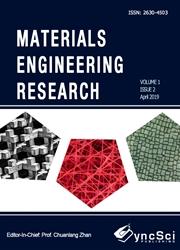The Comparative studies of mechanical and interfacial properties between jute and E-Glass fiber-reinforced unsaturated polyester resin based composites
引用次数: 3
Abstract
Jute fiber (hessian cloth)-reinforced unsaturated polyester matrix composites (50 wt% fiber) were fabricated by hand lay-up technique. Tensile strength (TS), tensile modulus (TM), bending strength (BS), bending modulus (BM), elongation at break (Eb%), and impact strength (IS) of the composites were found to be 42 MPa, 2.7 GPa, 36 MPa, 2.1 GPa, 3%, and 21 kJ/m2, respectively. On the other hand, TS, TM, BS, BM, and Eb% of E-glass mat reinforced unsaturated polyester resin (UPR) composite were found to be 70 MPa, 3.8 GPa, 80 MPa, 2.5 GPa, and 5%, respectively. Then E-glass/UPR based composites (50 wt% fiber) were fabricated and the mechanical properties were compared with those of the Jute/UPR based composites. It was observed that E-glass fiber-based composites showed almost double mechanical properties as compared to jute composites. The interfacial shear strength of the jute and E-glass fiber-based systems was investigated and found to be 21 kJ/m2 and 21.56 kJ/m2, respectively, measured using the single-fiber fragmentation test. After flexural testing, fracture sides of both types of the composites were studied by scanning electron microscope (SEM) and the results showed that poor fiber-matrix adhesion for Jute/UPR based composites when it compared to that of the E-glass fiber composites. However, it was found that the E-glass fiber based composite has better strength as compared to jute fiber composite.黄麻与e -玻璃纤维增强不饱和聚酯树脂基复合材料力学性能和界面性能的比较研究
采用手工叠层法制备了黄麻纤维(粗麻布)增强不饱和聚酯基复合材料(50%纤维)。拉伸强度(TS)、拉伸模量(TM)、抗弯强度(BS)、抗弯模量(BM)、断裂伸长率(Eb%)和冲击强度(IS)分别为42 MPa、2.7 GPa、36 MPa、2.1 GPa、3%和21 kJ/m2。另一方面,e -玻璃毡增强不饱和聚酯树脂(UPR)复合材料的TS、TM、BS、BM和Eb%分别为70 MPa、3.8 GPa、80 MPa、2.5 GPa和5%。然后制备了50%纤维含量的e -玻璃/UPR基复合材料,并与黄麻/UPR基复合材料的力学性能进行了比较。结果表明,e -玻璃纤维基复合材料的力学性能几乎是黄麻复合材料的两倍。对黄麻和e-玻璃纤维体系的界面抗剪强度进行了研究,通过单纤维破碎试验测得的界面抗剪强度分别为21 kJ/m2和21.56 kJ/m2。经过弯曲测试,通过扫描电镜(SEM)对两种复合材料的断裂面进行了研究,结果表明,黄麻/UPR基复合材料与e -玻璃纤维复合材料相比,纤维与基体的粘附性较差。然而,与黄麻纤维复合材料相比,e -玻璃纤维基复合材料具有更好的强度。
本文章由计算机程序翻译,如有差异,请以英文原文为准。
求助全文
约1分钟内获得全文
求助全文

 求助内容:
求助内容: 应助结果提醒方式:
应助结果提醒方式:


